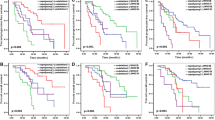Abstract
1p/19q codeletion is a favorable prognostic marker for oligodendroglial tumors (OT). Compare outcome in OT with simple deletions of 1p or 19q to those with relative deletions defined as the presence of both increased copy number (polysomy) and 1p/19q codeletion. 525 cases were examined by fluorescence in situ hybridization (FISH) using dual color probes to determine the deletion status of chromosome arms 1p and 19q. Categories included simple deletions defined as a proportion of either 1p32 or 19q13 FISH signals compared to 1q42 or 19p13 signals less than 0.80 and relative deletions (1p or 19q) defined as the combination of a <0.80 proportion with >30 % of nuclei showing increased chromosome number (based on enumeration of 1q25 or 19p13). 464 (80 %) were WHO Grade II or III OT of which 209 (48 %) had both 1p and 19q deleted (codeletion). 72 (16 %) had relative deletions for either one or both 1p and 19q of which 28 (6 %) had relative deletions of 1p and 19q (relative codeletion). Overall survival in WHO Grade II OT was 13 + years when 1p/19q codeleted (n = 156); 5 + years in uni- or nondeleted (n = 86); 6 + years in relative deletion for either 1p or 19q (n = 41); and 6 + years in relative 1p/19q codeletion (n = 15). Similarly in WHO Grade III OT (n = 168) overall survival was 11 + years in 1p/19q codeleted (n = 54) OT; 2.5 years in uni- or nondeleted (n = 70); 3 years in relative deletion for one or both 1p or 19q (n = 31); and 4 + years in relative 1p/19q codeletion (n = 13). Survival for OT regardless of grade with relative codeletion of 1p/19q was approximately one half that of 1p/19q codeleted tumors. The presence of relative 1p/19q codeletion is of prognostic significance.
Similar content being viewed by others
References
Cairncross JG, Ueki K, Zlatescu MC et al (1998) Specific genetic predictors of chemotherapeutic response and survival in patients with anaplastic oligodendrogliomas. J Natl Cancer Inst 90:1473–1479
Jenkins RB, Blair H, Ballman KV et al (2006) A t(1;19)(q10;p10) mediates the combined deletions of 1p and 19q and predicts a better prognosis of patients with oligodendroglioma. Cancer Res 66:9852–9861
Cairncross G, Wang M, Shaw E, Jenkins R et al (2013) Phase III trial of chemoradiotherapy for anaplastic oligodendroglioma: long-term results of RTOG 9402. J Clin Oncol 31:337–343
van den Bent MJ, Brandes AA, Taphoorn MJB et al (2013) Adjuvant procarbazine, lomustine, and vincristine chemotherapy in newly diagnosed anaplastic oligodendroglioma: long-term follow-up of EORTC brain tumor group study 26951. J Clin Oncol 31:344–350
Buckner J, Shaw E, Pugh S, et al. R9802: Phase III study of radiation therapy (RT) with or without procarbazine, CCNU, and vincristine (PCV) in low-grade glioma: Results by histologic type. Neuro Oncol 2014;16 (suppl5): AT-13. Abstract
Snuderl M, Echler AF, Ligon KL et al (2009) Polysomy for chromosomes 1 and 19 predicts earlier recurrence in anaplastic oligodendrogliomas with concurrent 1p/19q loss. Clin Cancer Res 15:6430–6437
Al Wiens, Cheng L, Bertsch EC et al (2012) Polysomy of chromosomes 1 and or 19 is common and associated with less favorable clinical outcome in oligodendrogliomas: fluorescent in situ hybridization analysis of 84 consecutive cases. J Neuropathol Exp Neurol 71:618–624
Ren X, Jiang H, Cui X et al (2013) Co-polysomy of chromosome 1q and 19p predicts worse prognosis in 1p/19q codeleted oligodendroglial tumors: FISH analysis of 148 consecutive cases. Neuro Oncol 15:1244–1250
Jiang H, Ren X, Zhang Z, Zeng W, Wang J, Lin S (2014) Polysomy of chromosomes 1 and 19: an underestimated prognostic factor in oligodendroglial tumors. J Neurooncol 120:131–138
Reifenberger G, Kros JM, Louis DN et al (2007) Oligodendroglioma and anaplastic oligodendroglioma. In: Louis DN, Ohgaki H, Wiestler OD et al (eds) WHO classification of tumours of the central nervous system. IARC Press, Lyon, France, pp 54–62
Fallon KB, Palmer CA, Roth KA et al (2004) Prognostic value of 1p, 19q, 9p, 10q, and EGFR-FISH analyses in recurrent oligodendrogliomas. J Neuropathol Exp Neurol 63:314–322
Weller M, Wick W (2014) Neuro-oncology in 2013: improving outcome in newly diagnosed malignant glioma. Nat Rev Neurol 10:68–70
Author information
Authors and Affiliations
Corresponding author
Ethics declarations
Conflict of interest
Authors report no conflict of interest related to this article.
Rights and permissions
About this article
Cite this article
Chamberlain, M.C., Born, D. Prognostic significance of relative 1p/19q codeletion in oligodendroglial tumors. J Neurooncol 125, 249–251 (2015). https://doi.org/10.1007/s11060-015-1906-y
Received:
Accepted:
Published:
Issue Date:
DOI: https://doi.org/10.1007/s11060-015-1906-y




